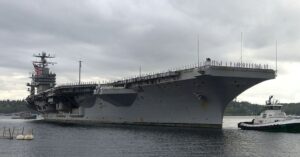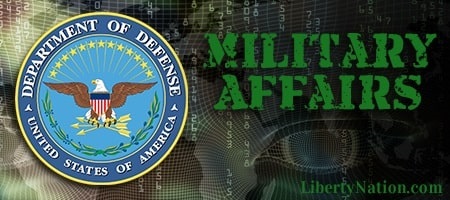President Joe Biden’s administration dispatched two aircraft carriers, the USS Gerald R. Ford and the USS Dwight D. Eisenhower, to eastern Mediterranean Sea locations. These, with their assigned complement of warships and support vessels, constitute a carrier strike group (CSG). The USS Ford, with the Ticonderoga-class guided-missile cruiser USS Normandy, Arleigh Burke-class destroyers USS Thomas Hudner, USS Ramage, USS Carney, and USS Roosevelt, were already in the Mediterranean near Italy, according to a US Naval Institute News report.
USS Ford strike group moved locations to the Eastern Mediterranean to support Israel in its war with Hamas. The US Defense Department dispatched the carrier as a show of force to dissuade Hezbollah in southern Lebanon from developing a second front to attack the Israeli Defense Force (IDF). USS Ford CSG had been in the Mediterranean Sea since June, establishing a continuous presence in response to Russia’s unprovoked invasion of Ukraine.
Aircraft Carriers Make a Powerful Statement
Despite the announced US naval presence close to southern Lebanon, Hezbollah attacked Israel with sporadic artillery and rocket fire. On Oct. 14, Biden deployed the USS Dwight D. Eisenhower CSG from Norfolk Naval Station. The Eisenhower strike group was going to Europe, according to an initial report in the Navy Times. Subsequently, its mission was changed to join USS Ford. The Eisenhower CSG will add the Ticonderoga-class guided-missile cruiser USS Philippine Sea and two Arleigh Burke-class destroyers, the USS Gravely and USS Mason.

USS Carl Vinson (Photo by Ron Wurzer/Getty Images)
Additionally, the USS Carl Vinson Nimitz-class aircraft carrier left San Diego Naval Base on Oct. 12 to take up position in the Indo-Pacific area. However, speculation is that the Vinson, with its attending warships, will support the Eisenhower and Ford. Should the USS Carl Vinson CSG rendezvous with the Ford and Eisenhower CSGs, the armada would include three Ticonderoga-class cruisers, 10 Arleigh Burke-class guided-missile destroyers, and assorted support ships. Each of the aircraft carriers in the CSGs typically carries an air wing, and, according to Chris Panella, writing for Insider:
“The Ford is operating with eight squadrons of attack and support aircraft, the US Central Command says. Carrier Airwing 8 is tasked with the defense of the carrier and conducting sustained air operations and consists of aviation assets such as multirole F/A-18E/F Super Hornets, electronic-warfare EA-18G Growlers, early-warning planes such as the E-2D Hawkeye, and rotary aircraft. Carrier air wings typically have more than 70 aircraft.”
That means, conceivably, the United States could have more than 210 combat aircraft to meet any threat. The E-2D Hawkeye’s capability to provide crucial 360-degree radar coverage, including information for air battle management and missile defense operations, is particularly helpful for the Israelis. At the same time, the EA-18G Growler aircraft provides electronic warfare equipment capable of shutting down Hamas and Hezbollah communications.
US Navy Show of Force Sends a Message
 Though it’s speculation about where the USS Carl Vinson CSG might end up, it would make sense to move from the Indo-Pacific region and take up a position in the northern Arabian Sea. The Vinson CSG would be geographically more capable of dealing with Iran directly if need be. Having these naval assets in place means the United States brings a formidable military capability to bear. “For instance, the carrier strike group, which is comprised of the carrier, a cruiser and four destroyers, could provide ballistic missile defense for Israel while its forces are preoccupied on other tasks, said Mark Montgomery, a senior director at the Foundation for Defense of Democracies,” Justin Katz explained in Breaking Defense. “Resupply is another role with which the carrier strike group could assist, multiple analysts noted in comments to Breaking Defense,” Katz said.
Though it’s speculation about where the USS Carl Vinson CSG might end up, it would make sense to move from the Indo-Pacific region and take up a position in the northern Arabian Sea. The Vinson CSG would be geographically more capable of dealing with Iran directly if need be. Having these naval assets in place means the United States brings a formidable military capability to bear. “For instance, the carrier strike group, which is comprised of the carrier, a cruiser and four destroyers, could provide ballistic missile defense for Israel while its forces are preoccupied on other tasks, said Mark Montgomery, a senior director at the Foundation for Defense of Democracies,” Justin Katz explained in Breaking Defense. “Resupply is another role with which the carrier strike group could assist, multiple analysts noted in comments to Breaking Defense,” Katz said.
Yet, it’s not enough to deploy an impressive show of force; the enemy must be convinced the United States would use that force if provoked. The pressure is building to have Biden back away from his strong support of Israel. Nonetheless, the president’s full carrier strike group in position to support the IDF sends a powerful message. Let’s hope Israel’s enemies get it.

